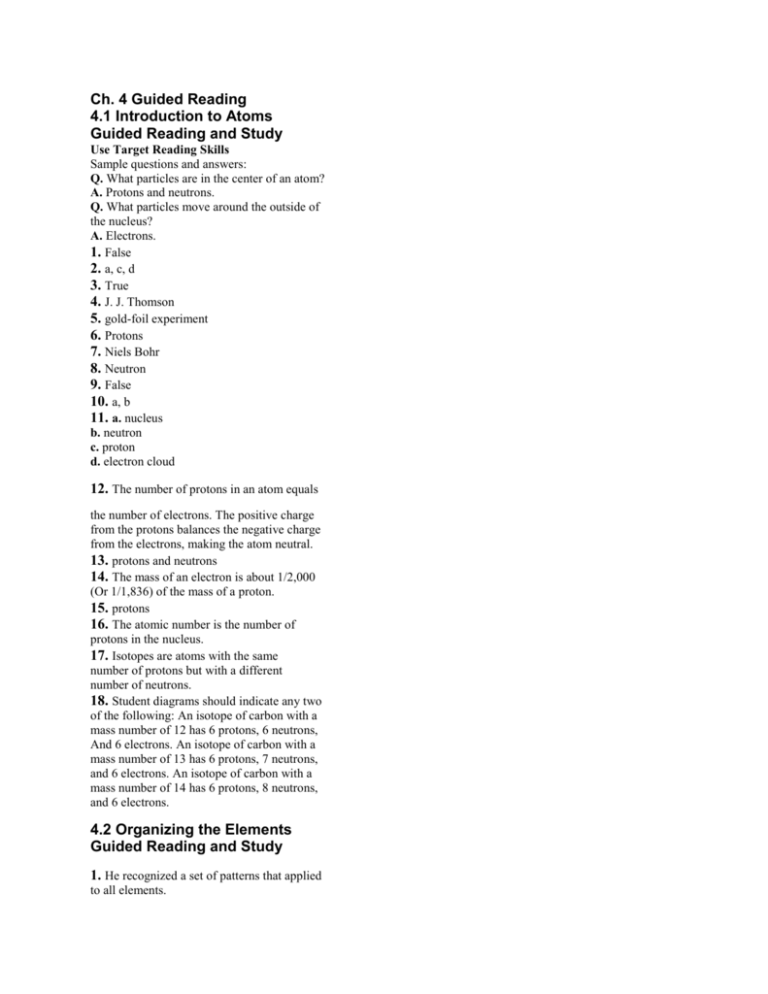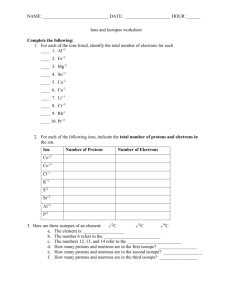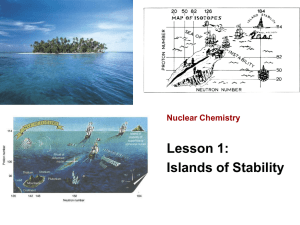Ch. 4 Guided Reading 4.1 Introduction to Atoms Guided Reading
advertisement

Ch. 4 Guided Reading 4.1 Introduction to Atoms Guided Reading and Study Use Target Reading Skills Sample questions and answers: Q. What particles are in the center of an atom? A. Protons and neutrons. Q. What particles move around the outside of the nucleus? A. Electrons. 1. False 2. a, c, d 3. True 4. J. J. Thomson 5. gold-foil experiment 6. Protons 7. Niels Bohr 8. Neutron 9. False 10. a, b 11. a. nucleus b. neutron c. proton d. electron cloud 12. The number of protons in an atom equals the number of electrons. The positive charge from the protons balances the negative charge from the electrons, making the atom neutral. 13. protons and neutrons 14. The mass of an electron is about 1/2,000 (Or 1/1,836) of the mass of a proton. 15. protons 16. The atomic number is the number of protons in the nucleus. 17. Isotopes are atoms with the same number of protons but with a different number of neutrons. 18. Student diagrams should indicate any two of the following: An isotope of carbon with a mass number of 12 has 6 protons, 6 neutrons, And 6 electrons. An isotope of carbon with a mass number of 13 has 6 protons, 7 neutrons, and 6 electrons. An isotope of carbon with a mass number of 14 has 6 protons, 8 neutrons, and 6 electrons. 4.2 Organizing the Elements Guided Reading and Study 1. He recognized a set of patterns that applied to all elements. 2. The atomic mass of an element is the average mass of all the isotopes of that element. 3. Patterns appeared when he arranged the elements in order of increasing atomic mass. 4. true 5. three 6. in a regular, repeated pattern 7. periodic table 8. atomic number 9. The properties of an element can be predicted from its location in the periodic table 10. period 11. true 12. b, c 13. b 14. Each calcium atom has 20 protons and 20 electrons. 15. chemical symbol 16. The symbols of some elements come from their Latin names. 17. a. Tin b. Sn c. 118.69 d. 50 4.3 Metals Guided Reading and Study 1. properties 2. c 3. d 4. c 5. b 6. a 7. magnetic 8. true 9. corrosion 10. The reactivity of metals tends to decrease from left to right across the periodic table 11. a, b 12. sodium and potassium 13. a, b, c 14. magnesium and calcium 15. a, c, d 16. true 17. false 18. They are placed below the periodic table. 19. They are located below the lanthanides 20. uranium 21. a. Alkali b. Alkaline c. Transition d. Lanthanides 22. They are synthesized when nuclear particles are forced to crash into one another. 23. curium. 24. false 4.4 Nonmetals and Metalloids Guided Reading and Study 1. nonmetals 2. They are located to the right of the metalloids. 3. true 4. a, b 5. compounds 6. b 7. All living things contain compounds that are made of molecules having chains of carbon atoms. 8. d 9. nitrogen gas 10. diatomic molecule 11. d 12. a, c, d 13. b 14. true 15. b, d 16. a. Group 14; Carbon b. Group 15; Nitrogen, phosphorus c. Group 16; Oxygen, sulfur, selenium d. Group 17; Fluorine, chlorine, bromine, iodine e. Group 18; Helium, neon, argon, krypton, xenon, radon 17. A hydrogen atom has only one proton and one electron. 18. The chemical properties of hydrogen differ very much from those of other elements. 19. Metalloids are elements that have some characteristics of both metals and nonmetals. 20. silicon 21. Their most useful property is their varying ability to conduct electricity. 22. Semiconductors are substances that can conduct electricity under some conditions but not under other conditions. 4.5 Radioactive Elements Guided Reading and Study 1. radioactive decay 2. Henri Becquerel discovered radioactive decay while studying a sample of a mineral containing uranium. 3. A sample of the mineral containing uranium and a photographic plate wrapped in paper 4. The image of the mineral rock was on the photographic plate. 5. radiation 6. They concluded that a reaction was taking place within the uranium nuclei. 7. radioactivity 8. a. Two protons and two neutrons; positive b. One electron; negative c. High-energy waves; neutral 9. a. Gamma radiation b. Beta decay c. Alpha decay 10. alpha particles 11. gamma radiation 12. b, c, d 13. Radioactive isotopes release energy and they give off detectable radiation. 14. Radioactive isotopes that can be followed through the steps of a chemical reaction or an industrial process 15. They give off radiation that can be detected. 16. a, b 17. A tracer used by the bones is injected into the body. Technicians use radiation-detecting equipment to make images of the bones. 18. Radioactive iodine is given to patients with thyroid tumors. The isotope collects in the thyroid gland and kills tumor cells.







